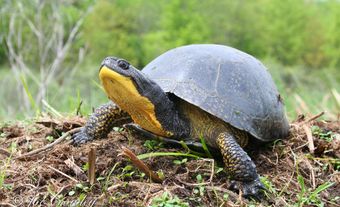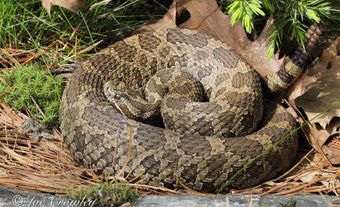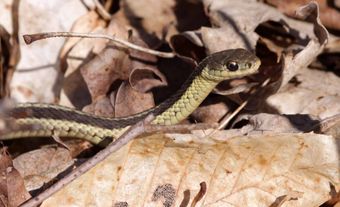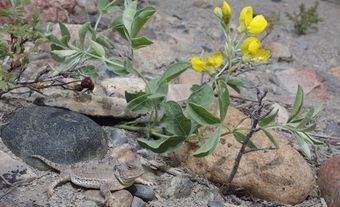The Eastern red-backed salamander (Plethodon cinereus) is a small woodland salamander that is native to Eastern North America. In Canada, this species is found from Prince Edward Island to Northwestern Ontario. A similar species, the Western red-backed salamander, is found in southwestern British Columbia. Eastern red-backed salamanders are abundant in most forests within their range. However, they often go unseen because they spend most of their time underground, under the leaf litter or objects such as logs, stumps and rocks.

Description
Eastern red-backed salamanders are small, slender salamanders that can grow to a total length of about 12.5 cm. They have short legs relative to their body. Eighteen to twenty depressed areas — known as costal groves — are on their sides, where the ribs are located. Individuals typically have one of two colour patterns, which are referred to as colour morphs. The striped or red-backed morph is dark grey to black with a red or orangish-red stripe that extends from the salamander’s head down its back. The unstriped or lead-backed morph is a uniform dark grey to black and lacks the stripe. Both morphs often have light-coloured flecking or mottling. Their bellies are speckled white and black. There are several other rare colour morphs, including albino individuals and an all-red morph (described by biologists as erythrism, or the unusual presence of red pigmentation).

Distribution and Habitat
In Canada, the Eastern red-backed salamander ranges from Prince Edward Island westward through New Brunswick, Nova Scotia, Southern Quebec, Southern and Central Ontario, and along the southernmost portion of Northwestern Ontario as far west as the Atikokan area (just west of Thunder Bay). This species is also found throughout the Northeastern United States as far west as Minnesota, Wisconsin and Illinois and as far south as North Carolina.
Eastern red-backed salamanders live in forests. Logs, stumps and other woody debris are important habitat features that provide cool, moist conditions and shelter from predators. During the hot, dry summer months, individuals often retreat into mammal burrows, root cavities, and other underground spaces that retain higher moisture levels than the ground’s surface. Eastern red-backed salamanders also rely on these underground refuges to get below the frost line and avoid freezing temperatures during the winter. Females lay their eggs in damp areas on the forest floor, such as under rotting logs. Eastern red-backed salamanders do not migrate between hibernation, breeding and summer habitats.
Male and female Eastern red-backed salamanders are territorial. They mark their territories using feces and chemical secretions and defend them from intruders. During territorial disputes, they communicate using aggressive and submissive posturing. If that fails to resolve the conflict, they will engage in combat.
Did you know?
Eastern red-backed salamanders belong to the family Plethodontidae. The species in this family do not have lungs! Instead, gases diffuse directly through their permeable skin. Their skin has to remain moist to perform this respiratory function, which is why Eastern red-backed salamanders are found in cool, damp habitats on the forest floor. If they are exposed to hot, dry conditions for too long, their skin will dry out and they will suffocate.
Reproduction and Development
Eastern red-backed salamanders typically mate in the fall. On average, females lay six to nine eggs in the late spring or early summer. The eggs are deposited in a grape-like cluster that is usually attached to the roof of the nest chamber. Females, and sometimes males, remain with the eggs to defend them until they hatch in August or September. Unlike most salamander species, Eastern red-backed salamanders are completely terrestrial and do not have an aquatic larval stage. Instead, their eggs undergo direct development, meaning the hatchlings look like miniature adults. Sexual maturity occurs at two to six years of age. Individuals at northern latitudes mature at the upper end of these ranges. In Canada, female Eastern red-backed salamanders typically reproduce every two years, while males will mate every year. There is little information on the lifespan of this species. However, one study in Quebec documented a maximum lifespan of nine years in the wild.
Diet and Predation
Eastern red-backed salamanders are most active at night, particularly during and following rainy weather when the forest floor is wet. They search for prey using sight and smell. They consume a wide variety of invertebrate species, including insects (e.g., ants, beetles, flies), spiders, mites, snails, slugs, centipedes and millipedes. Eastern red-backed salamanders are important predators in forest floor ecosystems. They influence the abundance of invertebrate communities and regulate the rates of ecological processes such as leaf litter decomposition.
The major predators of the Eastern red-backed salamanders are snakes and forest birds, as well as larger invertebrates such as spiders. Eastern red-backed salamanders produce noxious secretions from skin glands to deter predators. Like many species of salamanders, they may also drop their tails if they are attacked or handled roughly, which is known as tail autotomy. The tail, which continues to wriggle, can distract the predator while the salamander escapes. The tail will eventually grow back. However, when a salamander drops its tail, it can negatively affect their health and survival. This is because the tail contains fat reserves that the salamander depends on to survive the winter.

Status and Threats
Globally, the Eastern red-backed salamander is listed as “least concern” by the International Union for Conservation of Nature. This species is widespread and abundant in Canada, and its status has not been assessed by the Committee on the Status of Endangered Wildlife in Canada (COSEWIC). Activities that result in the permanent destruction of mature forest habitat, such as clearing land for urban development or agriculture, are the most serious threats to this species. Intensive forestry activities, such as clear-cutting, also negatively impact woodland salamanders. Because their skin is permeable to chemicals in the environment, amphibians are especially sensitive to chemical pollution such as pesticides, fertilizers, industrial chemicals, and road salt.
Eastern red-backed salamanders can be found in densities of more than one salamander per square metre of forest floor in healthy, old-growth forests. In some forests, plethodontid salamanders, including the Eastern red-backed salamander, may account for as much biomass (total weight) as small mammals and twice that of birds. Because of their abundance, sensitivity to environmental change, small home ranges, and important ecological roles in forest ecosystems, biologists often use Eastern red-backed salamanders as indicators of forest health. If salamander populations are stable and thriving, then this can indicate that the forest ecosystem is healthy.

 Share on Facebook
Share on Facebook Share on X
Share on X Share by Email
Share by Email Share on Google Classroom
Share on Google Classroom



